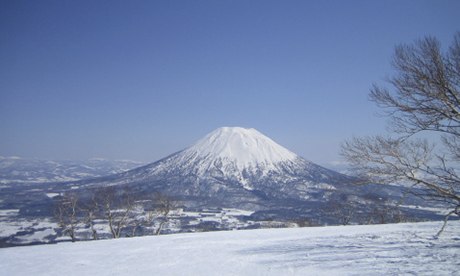
Scrambling on all fours to the summit and cursing the heavens wasn't how I imagined this ski experience would pan out. As the cold bit and the wind rumbled ominously, I started to question what on earth we were doing. But climbing up Mount Yotei, an active volcano, in search of deep powder was never going to be easy.
Most skiers coming to Japan's northern island of Hokkaido head for the popular resort of Niseko to experience its pristine snow. But for those who want a non-standard experience, scaling one of Hokkaido's most iconic volcanoes is too big a temptation to resist.
Yotei, often referred to as Ezo Fuji (or the Mount Fuji) of Hokkaido, is in the Shikotsu-Toya national park bordering the popular towns of Niseko, Kutchan and Makkari on the island's west coast. While skiing anywhere in Niseko, Yotei towers majestically in the distance, usually with small clouds billowing above its crater. At 1,898m, it is the highest mountain in the region and has the longest vertical ski descent in Hokkaido. Much planning is needed to make a successful ascent – bad weather comes in hard and fast in this region – so, from our base at the popular ski town of Hirafu in Niseko, we sought out a well-respected guide: Sam Kerr.
Sam is a New Zealander who runs Niseko Xtreme Tours, a local company specialising in back-country tours. We liaised with him over 10 days while waiting for the perfect conditions – there was much monitoring of weather patterns, avalanche reports and careful map-reading.
Finally, we hit the road at 8am one morning and, after an hour's drive, arrived at the base of the mountain. After putting on snowshoes, testing our avalanche transceivers (you would be surprised at how many people omit this vital bit of kit) and packing our shovels, probes, food, boots and skis, we set off for the day.
With no tracks in the snow before us, no sight of fellow hikers, and seeing Yotei suffused in the early morning light, we knew we'd chosen the right day.
It takes between six and eight hours to reach the summit. We left no margin for error, making it to the peak in five and a half hours, stopping only for food and water. This is no leisurely day on the slopes – it's a rigorous hike that will test your resolve and fitness.
With less than a quarter of the hike to go, it became clear the warm weather had created a hazardous challenge. The sugary top layer of snow was starting to break under our snow shoes, which left our feet sinking up to half a metre. Knowing our goal was to ski the deep powder inside Yotei's crater, we ploughed on.
The weather was deceptive above 1,000m – the bright sun bathed the mountain in a yellow glow and the winds were biting and dangerously cold but we pushed on and finally reached the crater's edge.
The crater itself was breathtakingly white from top to bottom; a classic bowl about 400m high with a 360-degree panoramic view. Although I am an advanced skier, the thought of plunging into this both terrified and exhilarated me. I watched the first three of our group descend into the soft, light powder and effortlessly glide down to the base. Then I went for it.
Pushing off from the ledge and skiing into the crater felt surreal. Unlike other powder runs in busy ski resorts, the beauty of this expedition was that we were allowed so much time and space to carve out beautiful lines with no competition on our backs. I was skiing on fresh powder that had been sitting on a base of untouched snow for weeks. For all my initial reservations, skiing on it felt effortless.
The main route down the northface starts off with an exciting 50-degree slope which leads into the open powder bowl. One side of the slope was extremely icy, while the other side was deep with fresh powder.
We were dubious about starting avalanches so we took the icy route, which was unnerving at times, but ultimately led us to one of the best runs of the season. Later, we had a half-hour descent through wonderful, untracked bottomless powder, then we hiked for about 40 minutes out of the crater and back to the top ridge of Mount Yotei before making our descent to where the cars were parked.
Back at base, Sam told us conditions needed to be near perfect to scale Yotei and ski into its crater. Approximately 100 people each winter attempt the climb and only around about 20 actually do it.
"Now that you have seen Yotei, you can understand its beauty and power," he said.
Sitting down that evening, sipping Hokkaido's famous plum wine, it was hard to believe we were part of the lucky 20% who managed to ski Mount Yotei's crater that winter. Scrambling on all fours and cursing the heavens was worth it in the end.

